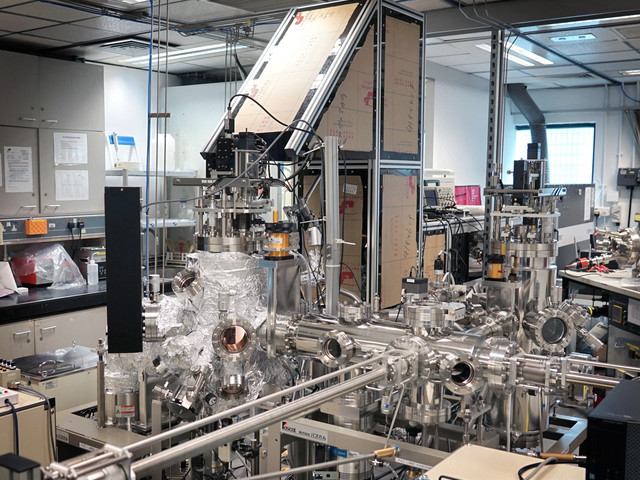The Department houses a wide range of experimental and computational equipment, and below are some highlights.
The Department houses a wide range of experimental and computational equipment, and below are some highlights.
DC Sputter deposition is one of a physical vapor deposition (PVD) method of thin film deposition by sputtering. This involves ejecting material from a "target" that is a source deposite onto a "substrate". The sputtering targets come in a wide variety of materials, including ceramic insulators, metal oxides, pure metals and alloys.

The D2 Phaser XRD system delivers data quality and collection speed that was thought impossible with a benchtop XRD system.

Philips X’Pert X-ray diffractometer (XRD) is a versatile device to characterise crystalline materials. It is capable of performing various types of measurements and analyses. It is mainly used for general diffraction work and phase analysis. In addition, it can determine the stresses in (sub) surface layers and line profile analysis. All measurements are done at room temperature.

Rigaku SmartLab is a new high-resolution X-ray diffractometer (XRD). It has a novel SmartLab Studio II software, which provides the user with an intelligent User Guidance expert system functionality that guides the operator through the intricacies of each experiment.

SAXS system is used for characterizing nanostructured materials and samples. It determines the size, size distribution and shape of nano-sized particles and sample domains and is especially suited for analyzing isotropic and colloidal.

The 5802 is a dual console system that is used when a scanning electron gun for Auger electron spectroscopy is added to the system. The separate vacuum console provides the vibration isolation devices needed for high spatial resolution scanning Auger microscopy.

The Time Resolved Fluorescence combines ultimate sensitivity with high spectral resolution and excellent stray light rejection, the wide wavelength range of 200 to 1650 nm enables steady state and time-resolved measurement over the ultraviolet, visible, and near-infrared regions.

Differential Scanning Calorimetry (DSC) is one of the most frequently employed Thermal Analysis methods. It can be used to analyze nearly all energetic effects occurring in a solid or liquid during thermal treatment.
Analysis possibilities:

The DMA is a new dimension for testing of solid and soft-solid materials. The most sensitive and accurate rotational shear measurements, the Discovery Hybrid Rheometer can deliver accurate linear DMA data. The DMA capability is available in: film tension, threepoint bend, cantilever, compression, etc.

Dynamic light scattering is based on the Photon Correlation Spectroscopy (PCS) technique and designed for measurements of sub-micron particle sizes, diffusion coefficients, viscosities, molecular weights of polymers in basic and applied studies.

JSM-IT500 is a new model of JEOL InTouchScope series. Equipped with sophisticated Analytical series, the embedded Energy Dispersive X-Ray Spectroscopy (EDS) system shows a real time EDS spectrum during image observation.

The Ambient Pressure Photoemission Spectroscopy (APS) system measures the absolute work function of a material by photoemission in air, no vacuum is required. With the addition of a surface photovoltage (SPV) and surface photovoltage spectroscopy (SPS), the full bands of semiconductors can be measured in the system as well.

Energy-dispersive X-ray fluorescence (XRF) offers all you need to measure and monitor elements in your samples, independent of the industry or environment in which you are working. The outstanding strength of XRF is the wide range of elements, from light elements like Sodium (Na), to heavy elements like Americium (Am).

Ellipsometry uses polarized light to characterize thin film and bulk materials. A change in polarization is measured after reflecting light from the surface. Thin film thickness and optical constants are derived from the measurement.

Cryogenic equipment capable of electrical, optical and several other measurements at temperatures down to 0.01 Kelvin and magnetic field of up to 12 Tesla.

The advanced cryogen-free DynaCool measurement platform with various modules/functions allows properties of materials to be conveniently measured at cryogenic temperatures (down to 2 Kelvin) and high magnetic field (9 Tesla), including resistivity, heat capacity, magnetization, susceptibility, and thermal expansion coefficient, etc.

This state-of-the-art high-vacuum laser molecular beam epitaxy (L-MBE) system equipped with reflection high-energy electron diffraction (RHEED), an apparatus for in-situ monitoring thin-film growth, enables atomic-precision fabrication of low-dimensional quantum materials. Being a key part, a powerful Coherent 205F excimer KrF laser is bundled to the system as the target-bombardment energy source for materials synthesis. With oxygen (among other supplied gases) environment, the system can grow a wide range of oxide materials in thin-film form, ideal for fundamental research and device applications. A connected E-beam evaporator allows various electrode and dielectric materials to be deposited onto film surfaces without contacting air, facilitating fabrication of high-quality metal-thin film interfaces.

Supported by a CRF grant from RGC, CityU contributed to the construction of Multi-physics Instrument (MPI) jointly with China Spallation Neutron Source (CSNS) and Dongguan Institute of Technology. MPI is a time-of-flight diffractometer dedicated to the study of disorder in complex materials. Total scattering data are collected with MPI and the data are analyzed using the pair-distribution-function (PDF) approach. MPI has broad applications covering physics, chemistry, materials science and engineering, and life sciences. On January 26, 2021, after two years of construction MPI received the first neutron beam from the target station, see the press release from Chinese Academy of Sciences. The instrument is now open to users.

The University’s centralized High-Performance Computing (HPC) cluster is under the Computing Services Centre's (CSC) management. The HPC is available for researchers to conduct computing intensive research projects in areas such as biomolecular simulation, artificial intelligence, machine learning, statistical analysis of large data sets, etc.
